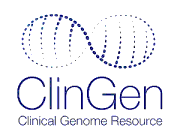The ClinGen Evidence Repository is an FDA-recognized human genetic variant database containing expert-curated assertions regarding variants' pathogenicity and supporting evidence summaries.
[Disclaimer]
Variant: NM_024675.3(PALB2):c.3249G>C (p.Glu1083Asp)
- Curation Version - 1.0
- Curation History
- JSON LD for Version 1.0
CA288472
126726 (ClinVar)
Gene: PALB2
Condition: hereditary breast cancer
Inheritance Mode: Autosomal dominant inheritance
UUID: 27b045d7-68a2-4cb4-b7f9-e2837a29e462
Approved on: 2023-04-05
Published on: 2023-04-07
HGVS expressions
NM_024675.3:c.3249G>C
NM_024675.3(PALB2):c.3249G>C (p.Glu1083Asp)
NC_000016.10:g.23607965C>G
CM000678.2:g.23607965C>G
NC_000016.9:g.23619286C>G
CM000678.1:g.23619286C>G
NC_000016.8:g.23526787C>G
NG_007406.1:g.38393G>C
ENST00000261584.9:c.3249G>C
ENST00000261584.8:c.3249G>C
ENST00000566069.5:n.117-4296G>C
ENST00000568219.5:c.2364G>C
NM_024675.4:c.3249G>C
NM_024675.4(PALB2):c.3249G>C (p.Glu1083Asp)
More
Evidence submitted by expert panel
The information on this website is not intended for direct diagnostic use or medical decision-making without review by a genetics professional. Individuals should not change their health behavior solely on the basis of information contained on this website. If you have questions about the information contained on this website, please see a health care professional.
